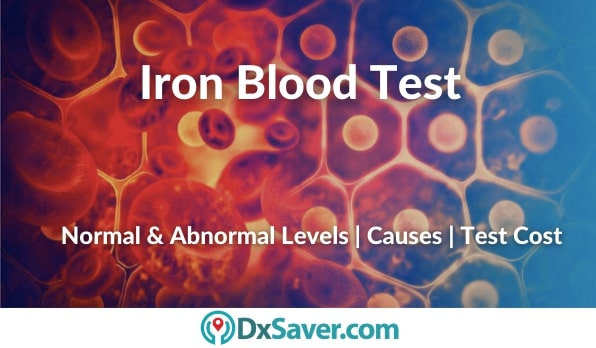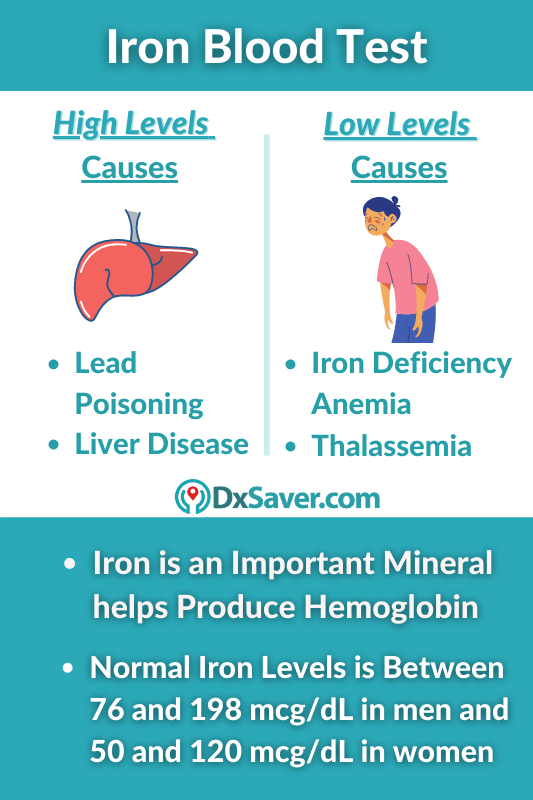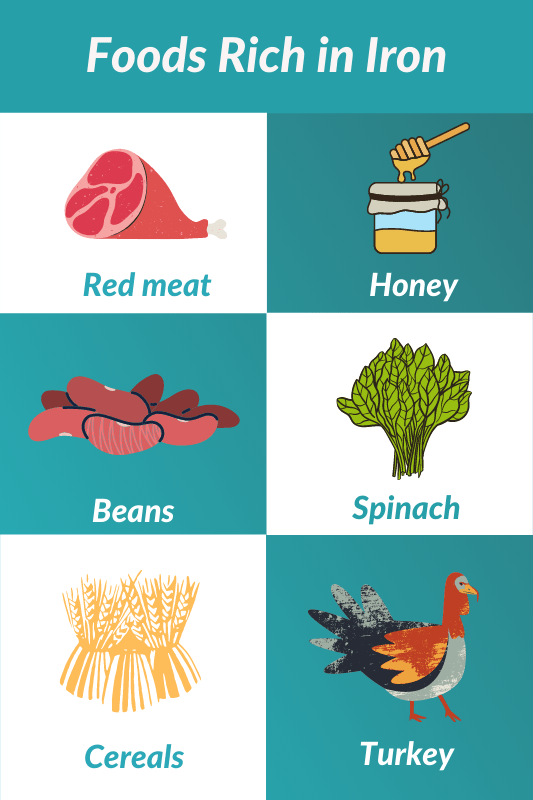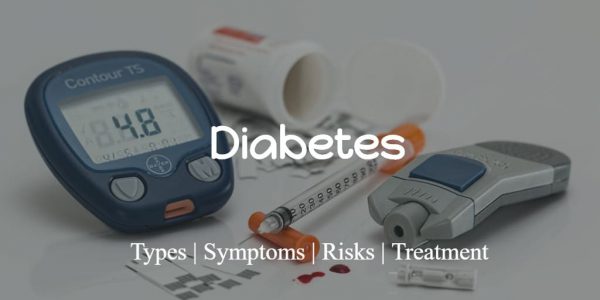
Iron content in your blood is an important mineral that your body uses to produce hemoglobin. Hemoglobin is responsible for transporting oxygen throughout the body. Iron is also needed for the proper functioning of muscles and other organs in your body. About 75% of the body’s iron is bound to hemoglobin in RBCs, and the rest of the iron content is stored either in your tissues or proteins (transferrin in blood or ferritin in bone marrow).
If the iron levels are abnormally high or low, it may indicate some medical conditions. Some symptoms of iron deficiency are fatigue, weakness, frequent infections, and feeling cold all the time. On the other hand, iron overload is symptomized as joint pain and abdominal pain. So, if you experience any iron deficiency or high symptoms, then we highly recommend getting tested for Iron levels in your blood
- Iron Blood Test Cost
- What is the iron in the blood test?
- What is iron in blood & why is it important?
- How is the iron blood test performed?
- Is there any preparation required before the Test?
- Are there any risks in the iron blood test?
- Iron blood test results explained
- Iron blood test: High
- Iron blood test: Low
- How to improve low iron levels in your blood?
- How to reduce high iron levels in your blood?
- Providers Locations
For our readers, who are very much interested in knowing the Iron Blood test cost beforehand, we would like to begin with that section.
Iron Blood Test Cost
The cost of the Iron blood test ranges between $28 and $53 in different labs and facilities across the U.S. No prior appointment is required. Compare the price, order your test online and visit the nearest lab during lab business hours. Complete the procedure and get the results in your email in 2 to 3 business days. Doctor consultation is also available for further treatment or for any kind of medical advice.
The following table shows the Iron blood test cost at 2 of our partner laboratories (CLIA – Certified) network located across the U.S.
Name of our Partner Labs | Book Online |
HealthLabs
| Offer Price$28 |
Personal Testing Labs
| Offer Price$53 |
Cost of Iron blood test cost with insurance
Many health insurance policies in the U.S. cover the cost of the iron blood test when it is done once or twice a year. If your physician recommends you to take an iron blood test more than twice in a year, you may have to pay the medical bill out of pocket. Also, the coverage offered by private health insurance policies and national health insurance programs varies widely. So we recommend you to check with your insurance company.
Our iron blood testing providers do not accept any health insurance. But, on request, they can provide you with a receipt containing all the details like the name and code of the test, and CPT code which is necessary for insurance reimbursement purposes.
What is Iron Content in the Blood Test?
Iron is an important mineral in your body. This mineral is not produced by our body rather absorbed from the foods or supplements we intake. Foods that are high in iron are red meat, beans, spinach, and fortified cereals. Generally, iron deficiency is not common in adults, as most people get a sufficient amount of iron from the diet consumed. However, some people do not get enough iron, or the iron consumed is not fully absorbed will fall into iron deficit resulting in health complications. Some people have higher needs of iron than the normal amount irrespective of their age and gender, such as pregnant women.
Iron levels should be at the required levels according to your age and sex in order to produce hemoglobin in your Red Blood Cells (RBCs). Hemoglobin is a protein that transports oxygen from your lungs to the other parts of the body. Thus a deficiency in iron content leads to low hemoglobin content and deprivation of oxygen in your bloodstream.
Therefore an iron blood test is taken to evaluate whether you are having enough amount of iron in your blood and to check for health conditions like anemia, or iron overload (excess iron).
What is Iron in Blood & Why is it Important?
An iron blood test is done to estimate the iron levels circulating in your blood, i.e. it measures the red blood cell production and destruction, iron metabolism, or iron transport in your blood.
Generally, iron is not manufactured by human anatomy, you get iron from the diet as a nutrient during digestion. When you run low on iron, it is termed as iron deficiency, where you will experience anemia, weakness, fatigue, and chest pain. In the case of excess iron in your bloodstream can cause joint point, weakness, stomach, or chest pain. Thus, it is important to have the exact amount of iron content in your blood to avoid severe health complications.
The iron blood test is recommended as a part of a wellness routine check-up and to prevent serious illnesses from occurring.
How is the Iron blood test performed?
As the name suggests, the Iron blood test is a simple blood test. During this test, a lab technician or a phlebotomist will cleanse the skin with an antiseptic and place an elastic band around the upper arm so that the vein becomes visible and swells with blood. He/she then injects a needle and draws a sample of blood in a test tube. After the blood is drawn, he covers the injected area with a band-aid to stop bleeding. The typical blood specimen is then sent to the lab for analysis.
It takes less than 10 minutes to perform this test.

Is there any preparation required before the test?
You will be asked to fast (not to consume any food or drink) for 12 hours before your test. Your concerned physician will give you specific instructions on diet. The iron blood test is usually done in the morning. Other than these, there are no special preparations required before the test.
Are there any risks in the Iron blood test?
There is no possible risk or complication in taking the Iron blood test. You might have slight pain or bruise in the injected area for a very little period.
Iron blood test results explained
Iron blood test results vary widely as per your age and gender. Healthy men should have iron levels between 76 and 198 micrograms per deciliter and healthy women needs to have between 50 and 120 mcg/dL.
In some cases the iron blood test may tend to be higher or lower than the normal range, this doesn’t explicitly mean you are under a certain medical condition. Your levels can be temporarily influenced due to some medications taken these include birth control pills, antibiotics, aspirin, estrogen, and testosterone. Sometimes, women may show low iron levels during their menstrual cycles.
Iron blood test: High
If your iron blood test shows more than 198 micrograms per deciliter (in men) or 120 mcg/dL (in women) then your iron levels are higher than normal. High iron levels are also knowns as iron overload or iron poisoning.
Causes of high iron levels in your blood:
- Hemochromatosis (a disorder that causes too much iron to build up in the body)
- Lead poisoning
- Liver disease
Symptoms of high iron levels (iron overload or iron poisoning):
- Joint pain
- Abdominal pain
- Lack of energy
- Weight loss
- Darkening of the skin
- Fatigue
- Heart problems
- Lack of sex drive
- Muscle weakness
Iron blood test: Low
If your iron blood test shows less than 76 micrograms per deciliter (in men) or 50 mcg/dL (in women) then your iron levels are lower than normal. Iron deficiency can most commonly be treated with iron supplements and taking an iron-rich diet.
Causes of low iron levels or iron deficiency:
- Iron deficiency anemia. (An anemia is a disorder in which your body doesn’t make enough red blood cells.)
- Other type(s) of anemia
- Thalassemia, an inherited blood disorder that causes the body to make fewer than normal healthy red blood cells
Symptoms of low iron levels in the blood:
- Pale skin
- Fatigue
- Weakness
- Dizziness
- Shortness of breath
- Rapid heartbeat
- Misshapen nails
- Tongue and mouth sores
- Difficulty concentrating
- Pica (the compulsion to eat non-food items, such as paper or ice chips)
How to improve low iron levels in your blood?
Iron deficiency or low iron levels can often be treated by taking iron supplements and foods that are rich in iron content. Some people can experience constipation when iron supplements are consumed, nonetheless, your physician will also recommend a stool softener. Also, iron may turn your stools dark in color, which is negligible as it a harmless side effect.
Iron supplements for low iron levels
Iron supplications are available in over-the-counter drug stores, your concerned physician will recommend which tablet and dosage will be suitable for you according to your age and gender with respect to the deficiency levels. Also, it is recommended to take the following other supplements to enhance the body’s iron absorption levels in order to make sure, the supplements intaken are helping in recovering the lost iron levels quickly and effectively.
- Don’t take iron with antacids. If you are taking antacids medications to relieve heartburn symptoms, then you need to take iron either 2 hours before or 4 hours after you take the antacids. Otherwise, the antacids medications can interfere with the absorption of iron and may result in the ineffectiveness of the iron supplements.
- Take vitamin C along with iron. Vitamin C acts as a catalyst by helping improve the absorption of iron. Thus, taking iron tablets with vitamin C supplements or a glass of orange juice (orange is rich in vitamin C) will have better results in iron intake.
- Iron tablets on an empty stomach is recommended. If you do not have an ulcer or stomach complaints, it is advisable to take iron tablets when your stomach is empty. However, many people can experience stomach upset when iron tablets are taken on an empty stomach, if that’s your case too, then you can take your iron tablets with meals.
Having very low iron levels or iron deficiency for a long time can’t be rectified by taking supplements overnight. You will be asked to continue taking the supplements for a long period of time, weeks, or even months to replenish your iron levels.
Typically, after a week of the treatment, you will start getting better results, however, your doctor will recommend taking an iron blood test again to recheck whether your iron levels are fully restored, if not you will be asked to continue with the supplements for another stipulated period of time.

Iron-rich foods to eat for low iron levels
Slightly low iron levels can be boosted back by taking the following iron-rich foods in your diet –
- Red meat
- Beans
- Spinach
- Fortified cereals
How to reduce high iron levels in your blood?
Too much iron means iron poisoning or iron overload, which can be deadly if not taken early treatment. Treatment for high iron levels involves a method called whole bowel irrigation. During this method of treatment, a special solution is swallowed or given via a tube that is passed down to the stomach through the nasal chamber. This solution helps in cleansing and execrating the excess iron levels in your body.
In the case of severe cases, when abnormally high iron levels are needed to be excreted out of the body immediately, a process called chelation will be recommended. In this case, instead of a solution give to swallow, a chemical that helps bind the excess iron is given through an intravenous (IV) line. Then, the iron is passed out of the human anatomy through the urine.
Iron poisoning is less common in grown adults, but the condition is more commonly seen in children.
Providers Locations
The Iron blood test can be done in any of the following locations across the U.S. by visiting the nearest lab. To know the Iron blood test cost, refer to the first section of the article.
- Alabama
- Arizona
- Arkansas
- California
- Colorado
- Connecticut
- Delaware
- Florida
- Hawaii
- Georgia
- Idaho
- Illinois
- Indiana
- Iowa
- Kansas
- Kentucky
- Louisiana
- Maine
- Michigan
- Minnesota
- Mississippi
- Missouri
- Montana
- Nebraska
- Nevada
- New Hampshire
- New Mexico
- North Carolina
- North Dakota
- Oklahoma
- Oregon
- Pennsylvania
- Puerto Rico
- South Carolina
- South Dakota
- Tennessee
- Texas
- Utah
- Vermont
- Virginia
- Washington
- West Virginia
- Wisconsin
- Wyoming
Frequently Asked Questions
Will insurance cover my testing cost?
No, insurance will not be covered in the billing. However, they will provide you a receipt for insurance reimbursement purposes.
How should I book my appointment?
You can choose the most suitable provider from above and make an appointment by following the instructions mentioned by them.
Can I cancel my lab test order?
Yes, you can cancel your lab test order anytime before your testing. A refund will be initiated after deducting the cancellation fee. However, cancellation is at the discretion of the provider.
Do the providers offer result interpretations?
Yes, a few providers may provide doctor consultation who will take you through the results and provide clarification if needed.
How do I receive my report?
To ensure your privacy, the test report will be mailed to you by the provider.
Other topics you may be interested in:-
- What are Heavy Metal Toxicity and its Treatment methods?
- Symptoms of Gluten Intolerance
- Is Itching a Symptom of STD?
- Signs and Symptoms of Oral Syphilis
- H Pylori Test Cost in the US
- Calcium Blood Test Cost Near Me
- ANA Blood Test Cost
- STDs that cause Dry Skin
- STD Testing Cost in the US
- What are MCH levels in a Blood Test?
- Cost of Planned Parenthood STD Testing Vs. Other Labs/Clinics Near You
- Normal Hematocrit, HCT Levels in Blood
- Types of STDs that cannot be cured
- Importance of Progesterone & Fertility Testing
- C-Peptide Normal Levels, Test Results & Treatment
- Oral STDs: Names, Symptoms, Treatment and Testing Cost
- Herpes Vs. HPV: Differences, Symptoms, and Testing Cost
- Types of STDs That Cause Skin Rashes on Genitals and Body
- Do STDs cause Blood in Urine? Know more on Other Symptoms of STDs






